Robert H. Whittaker’s five classification system, Processed in 1969, characterizes living organisms into Five-Kingdom Classification: Kingdom Monera, Kingdom Protista, Kingdom Fungi, Plant Kingdom, and Animalia. This classification is based on the organism’s cell structure, mode of nutrition, and complexity of its body structure. Keep in mind that this classification has been refined and modified over time, and more modern systems like the three-domain system have been proposed.
Here we have briefly discussed the animal kingdom below in the article. The animal kingdom is a part of class 11th-class biology syllabus, and it is one of the most important topics for the NEET Exam.
What is Animal Kingdom?
The Animal kingdom, also known as the kingdom Animalia, includes a diverse range of multicellular organisms that are heterotrophic, meaning they obtain their nutrients by consuming other organisms. Animals are characterized by their ability to move, have specialized cells and tissues, and generally exhibit a more complex level of organization compared to other kingdoms.
This kingdom encompasses a vast array of creatures, from simple microscopic organisms to highly complex ones like mammals, birds, reptiles, amphibians, and insects. The Animal kingdom is further divided into – Vertebrates and Invertebrates. Then these vertebrates and invertebrates are further divided into different phyla they are Porifera, Cnidaria, Platyhelminthes, Nematoda, Annelida, Arthropoda, Mollusca, Echinodermata, and Chordata.
| Division of Animal Kingdom | |
| Divisions | Description |
| Vertebrates | Animals with a backbone, including mammals, birds, reptiles, amphibians, and fish, exhibit complex nervous systems and internal skeletons. |
| Invertebrates | Animals lacking a backbone, such as insects, mollusks, and worms, are diverse groups with varied body structures and habitats. |
Characteristics of the Animal Kingdom
The different characteristics of the Animal Kingdom are:
- Organisms in the Animal kingdom are composed of multicellular cells, which work together to perform various functions.
- Animals are unable to produce their own food through photosynthesis and must obtain nutrients by consuming other organisms.
- Most animals have the ability to move at some point in their life cycle, whether it’s through crawling, swimming, flying, or walking.
- Animals often possess a nervous system that enables them to process information and coordinate their bodily functions and responses.
- Many animals have well-developed sense organs, such as eyes, ears, nose, skin, and tongue which allow them to perceive and respond to their environments.
Examples of the Animal Kingdom
Here we have discussed a few examples of the vast diversity found within Animal Kingdom. Each of these groups includes a wide range of species with their unique characteristics and adaptations.
| Examples of Animal Kingdom | |
| Groups Included in the Animal Kingdom | Examples |
| Mammals | Humans (Homo sapiens), Dogs (Canis lupus familiarise), Cats (Felis catus), Elephants (Loxodonta spp.), Dolphins (Delphinidae). |
| Birds | Eagles (Aquila spp.), Sparrow (Passeridae), Penguins (Sphenicidae), Owl (Strigiformes). |
| Reptiles | Snakes (Serpentes), Turtles (Testudines), Lizards (Lacertilia), Crocodiles (Crocodylidae). |
| Amphibians | Frogs (Anura), Salamanders (Caudata). |
| Fishes | Goldfish, Sharks, Clownfish, Slmon. |
| Insects | Butterflies (Lepidoptera), Ants (Fomicidae), Beetles (Coleoptera), Flies (Diptera). |
| Arachnids | Spiders, Scorpions, Ticks, Mites. |
| Mollusks | Snails, Clams, Squids, Octopuses. |
| Echinoderms | Starfish, Sea urchins, Sea cucumbers, Brittle stars. |
| Cnidarians | Jellyfish, Corals, Sea anemones, Hydra. |
Phyla in the Animal Kingdom
The Animal kingdom is typically divided into several phyla, including Chordata, Arthropoda, Mollusca, Annelida, Porifera, Cnidaria, and Echinodermata, and others. Each phylum represents a major group of animals with distinct characteristics and traits.
| Phyla in the Animal Kingdom | ||
| Phylum | Description | Example |
| Chordata | Possess a notochord and dorsal nerve cord. | Humans, Fish |
| Arthropoda | Segmented bodies, exoskeleton, jointed appendages. | Insects, Crustaceans |
| Mollusca | They have soft bodies often covered by shells. | Snails, Squids |
| Annelida | Segmented bodies, often with setae (Bristles). | Earthworms, Leeches |
| Porifera | Simple aquatic animals having asymmetrical bodies with pores. | Sponges |
| Cnidaria | Radial symmetry, stinging cells (cnidocytes). | Jellyfish, Corals |
| Echinodermata | Spiny skin, often with five-fold symmetry. | Starfish, Sea Urchins |
| Platyhelminthes | Flatworms with simple body structures. | Tapeworms, Flatworms |
| Nematoda | Unsegmented roundworms with a tough cuticle. | Roundworms |
| Hemichordata | Marine phylum with tripartite body plan, bridging characteristics of chordates and echinoderms. | Acorn Worms or Balanoglossus |
1. Chordata
The phylum Chordata includes a diverse group of animals that share certain defining characteristics. Cordata is divided into three subphyla: Urochordata (Tunicates), Cephalochordata (Lancelets), and Vertebrata (Vertebrates). Here are the key points about Chordata.
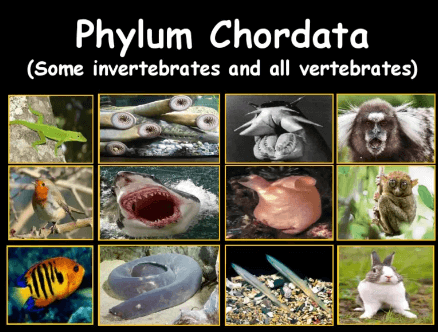
- Notochord: Chordates possess a notochord, a flexible rod-like structure that runs along the length of the body. In most vertebrates, the spine is during development.
- Dorsal Nerve Cord: Chordates have a dorsal nerve cord, which is a hollow tube located on their dorsal (back) side. This nerve cord develops into the central nervous system.
- Pharyngeal slits: Chordates have pharyngeal slits, which are openings in the pharynx (throat) area. These slits serve various functions in different groups of chordates, such as filter feeding in some aquatic species or developing into gills in fish.
- Endostyle or thyroid Gland: Chordates have an endostyle or thyroid gland, which is involved in the secretion of various substances, including hormones related to metabolism.
- Post-anal Tail: Chordates typically have a tail that extends beyond the anus, at least during some point in their development.

| Subphyla of Chordata | |
| Subphylum | Description |
| Urochordata (Tunicates) | Marine animals that show chordate characteristics only during their larval stage. As adults, they often have a more simplified body plan. |
| Cephalochordata (Lacelets) | Small marine animals with a body shape that resembles the ancestral chordate form. They retain chordate features throughout their lives. |
| Vertebrata (Vertebrates) | Animals with a backbone or spine, including fish, amphibians, reptiles, birds, and mammals. Vertebrates are the most familiar and diverse group within the Chordata phylum. |
2. Arthropoda
Arthropoda is a diverse and highly successful phylum of animals that includes insects, arachnids, crustaceans, and more. Here are the key points about Arthropoda:
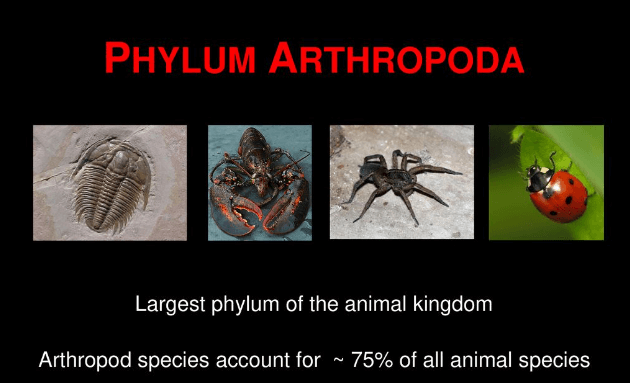
- Exoskeleton: Arthropods have a hard exoskeleton made of chitin, a tough and protective material. This exoskeleton provides support, protects the body, and serves as an attachment point for muscles.
- Segmented Body: Arthropods have a segmented body with distinct body regions: the Head, Thorax, and Abdomen in insects, and the Cephalothorax and abdomen in arachnids and crustaceans.
- Jointed Appendages: One of the defining features of arthropods is their jointed appendages, which include legs, antennae, and mouthparts. These allow for a wide range of movements and specialized functions.
- Molting: Arthropods undergo molting, a process where they shed their exoskeleton to allow for growth. After molting, the new exoskeleton is softer and gradually hardens.
- Respiratory Structures: Arthropods have various respiratory structures. Insects typically use a system of tubes called tracheae to deliver oxygen directly to cells. Aquatic arthropods like crustaceans have gills.
- Largest Animal Group: Arthropods make up the largest and most diverse group of animals, with millions of species described and potentially many more undiscovered. They have adapted to various niches and involved numerous specialized features.
3. Mollusca
Mollusca is a diverse phylum of animals that includes a wide range of species, from snails and clams to octopuses and squid. Here are the key points about Mollusca:
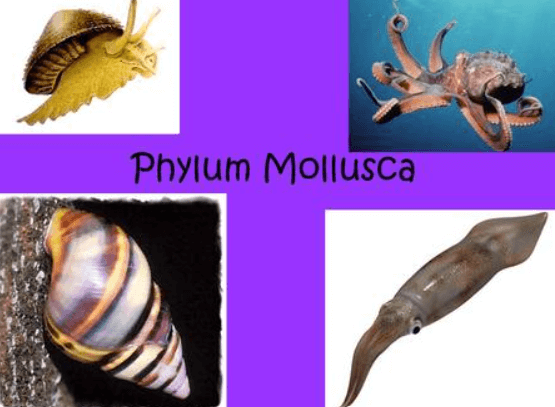
- Soft Body: Mollusks have a soft body that is often protected by a hard shell made of calcium carbonate. The shell is secreted by a specialized tissue called the mantle.
- Mantle: The mantle is a thin layer of tissue that covers the mollusk’s body and secretes the shell. It can also have other functions, such as respiration and excretion.
- Foot: Most mollusks have a muscular foot that they use for various purposes, such as locomotion, burrowing, and attachment.
- Gastropods: This subgroup includes snails and slugs. They are the largest and most diverse class of mollusks, with a wide range of shell shapes and sizes.
- Bivalves: This subgroup includes clams, mussels, and oysters. They have two shells connected by a hinge and often live in aquatic environments.
4. Annelida
Annelida is a phylum of segmented worms that includes a variety of species with distinctive characteristics. Here are the key points about Annelids.
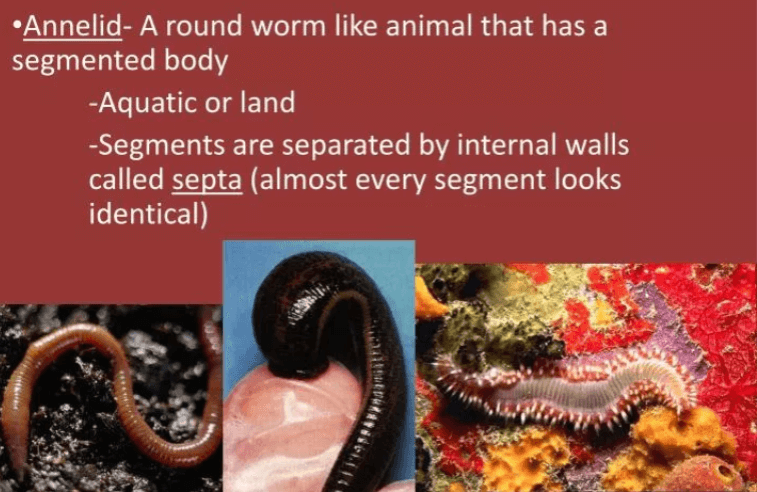
- Segmented Body: Annelids have bodies composed of repeating segments, giving them a segmented appearance. Each segment contains a set of organs and structures.
- Hydrostatic Skeleton: Annelids have a hydrostatic skeleton, which is a fluid-filled internal cavity that provides support and allows for movement. Muscles press against this fluid to create motion.
- Coelom: Annelids have a true coelom, a fluid-filled body cavity completely lined with mesoderm. This coelom allows for greater complexity in organ development and movement.
- Setae: Most annelids have bristle-like structures called setae on their body segments. Setae provide traction for movement and are used for burrowing.
- Respiration: Annelids employ various respiratory methods. Some have gills, while others exchange gases through their moist skin.
- Reproduction: Annelids can reproduce both sexually and asexually. Many species are hermaphroditic, meaning each individual has both male and female reproductive organs.
5. Porifera
Porifera commonly known as Sponges, is a phylum of simple aquatic animals that exhibit unique characteristics. Here are the key points about Porifera:
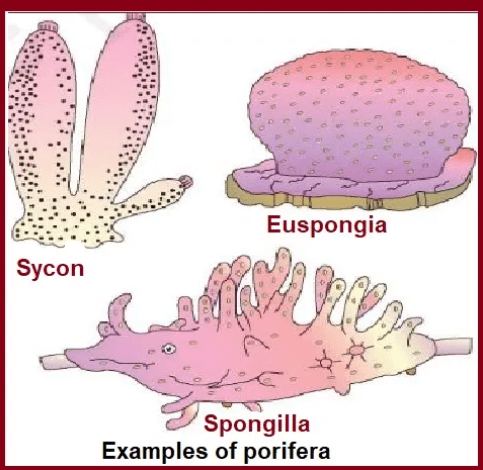
- Simple Body Structure: Sponges have a relatively simple body structure with no true tissues or organs. They consist of specialized cells organized into various layers.
- Filter Feeding: Sponges are filter feeders, meaning they obtain nutrients by pumping water through their bodies and filtering out small particles, such as bacteria and plankton.
- Aquatic Habitat: Sponges are primarily aquatic and are found in both freshwater and marine environments, from shallow waters to deep-sea habitats.
- Porocytes and Ostia: Porocytes are specialized cells that form tiny openings called ostia, allowing water to enter the sponge’s body. Water circulation is crucial for feeding and gas exchange.
- Collar Cells (Choanocytes): Choanocytes line the inner layer of the sponge and have flagella (whip-like structure) that create water currents and capture food particles.
- Chemical Compounds: Sponges are known for producing a wide range of bioactive compounds, some of which have potential pharmaceutical and biomedical applications.
6. Cnidaria
Cnidaria is a phylum of aquatic animals that includes a variety of species, many of which exhibit unique stinging structures called cnidocytes. Here are the key points about cnidaria:
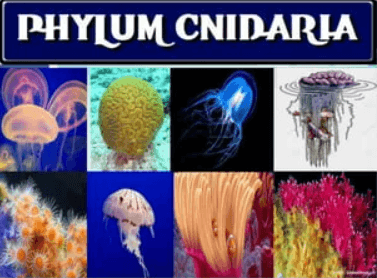
- Radial Symmetry: Cnidarians typically have radial symmetry, meaning their body parts are arranged around a central axis. This allows them to capture prey from all directions.
- Cnidaria: Cnidarians possess specialized cells called Cnidocytes, which contain nematocysts-stinging capsules. These capsules are used for defense and capturing prey.
- Two Body Forms: Cnidarians have two main body forms: the polyp and the medusa. Polyps are typically sessile and cylindrical, while medusas are bell-shaped and free-swimming.
- Classes: Cnidaria includes four main classes: Hydrozoa (Hydras and Portuguese man-of-war), Scyphozoa (True jellyfish), Cubozoa (Box jellyfish), and Anthozoa (Corals and sea anemones).
- Bioluminescence: Some cnidarians exhibit bioluminescence, producing light through chemical reactions. This can serve various purposes, including attracting prey or confusing predators.
7. Echinodermata
Echinodermata is a phylum of marine animals known for their unique radial symmetry and spiny skin. Echinoderms exhibit a variety of adaptations that have allowed them to inhabit diverse marine ecosystems. Sea urchins can have both positive and negative impacts on marine habitats, while sea cucumbers are valued in some cultures as food. Their unique features, such as the water vascular system and regenerative abilities, contribute to their importance in marine ecosystems.

8. Nematoda
Nematodes also known as roundworms, are a diverse group of animals belonging to the phylum Nematoda. Nematodes exhibit a wide range of adaptations that allow them to thrive in various environments, from the soil to the depths of the ocean. Their ecological importance, economic impact, and use as research subjects make them fascinating and important members of the animal kingdom.
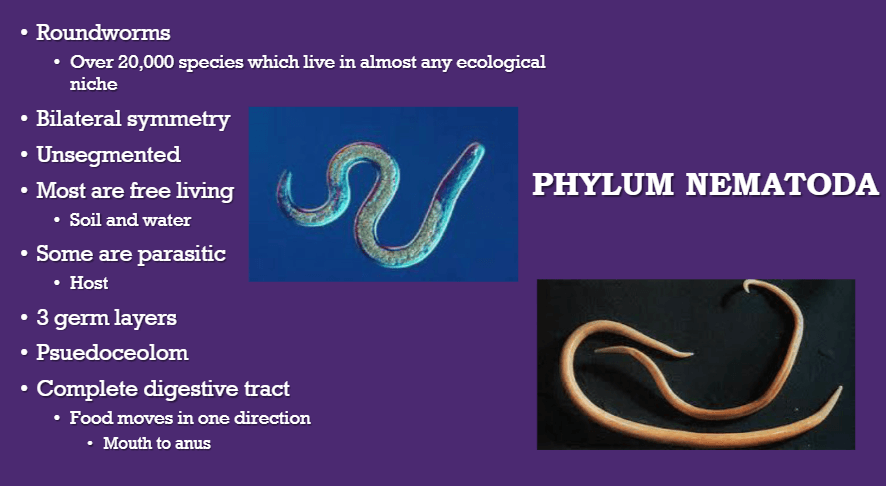
9. Hemichordata
Hemichordata is a phylum of marine animals that includes a group of organisms with some characteristics of both chordates and echinoderms. Hemichordates represent a fascinating and relatively less studied group of marine animals that provide valuable information about the evolution of various features found in different phyla. The main example of Hemichordata is Balanoglossus.
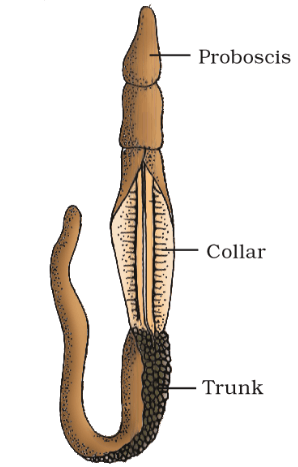
10. Platyhelminthes
Platyheminthes, also known as flatworms, is a diverse phylum within the animal kingdom. They are characterized by their flat, unsegmented bodies and a simple digestive system. They exhibit a wide range of adaptations and lifestyles, from free-living predators to complex parasitic species.
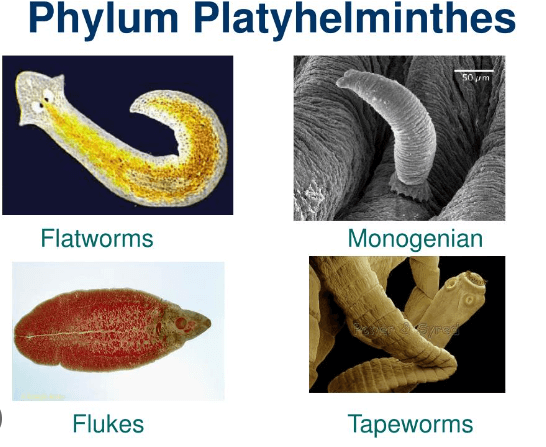
Important Questions About Animal Kingdom
Here we have discussed some important questions that can be asked related to the animal kingdom.
Q1. What is the animal kingdom?
Answer: The animal kingdom, or animalia, encompasses a diverse group of multicellular organisms. These creatures range from simple, immobile forms like sponges to complex, mobile animals such as mammals. They obtain energy by consuming other organisms and exhibit a wide variety of body structures, occupying diverse habitats globally.
Q2. How many phyla are there in the animal kingdom?
Answer: There are over 30 recognized phyla within the animal kingdom. The exact number may change as scientific research and classification evolve. These phyla encompass the various major groups of animals with distinct characteristics and evolutionary histories.
Q3. Which is the largest phylum of the animal kingdom?
Answer: The largest phylum in the animal kingdom is Arthropoda, which includes creatures like insects, spiders, crustaceans, and more. Arthropods are incredibly diverse and can be found in various habitats worldwide.
Q4. How is the animal kingdom useful to us?
Answer: The animal kingdom is essential to humans for various reasons. It provides food sources, manufactures medicines, offers companionship as pets, aids in scientific research, and contributes to ecological balance, enriching our lives and sustaining Earth’s ecosystem. Moreover, animals play roles in pollination, nutrient cycling, and medicine development, benefiting our well-being and ecosystem health.
Q5. In which phylum are nematocysts found?
(a) Porifera
(b) Cnidaria
(c) Annelida
(d) Mollusca
Answer: (b) Cnidaria
Q6. Which group of animals is characterized by having a pseudocoelom?
(a) Annelids
(b) Nematodes
(c) Arthropods
(d) Platyhelminthes
Answer: (b) Nematodes
Q7. What is bilateral symmetry?
Answer: Bilateral symmetry means an animal’s body can be split into two equal mirror-image halves through one straight line. This means the left and right sides look the same. It’s like how your left hand looks like your right hand. Most animals, including humans, show this kind of symmetry. It helps them move easily and stay balanced. Bilateral symmetry is a common and useful feature in nature that makes animals look neat and organized.

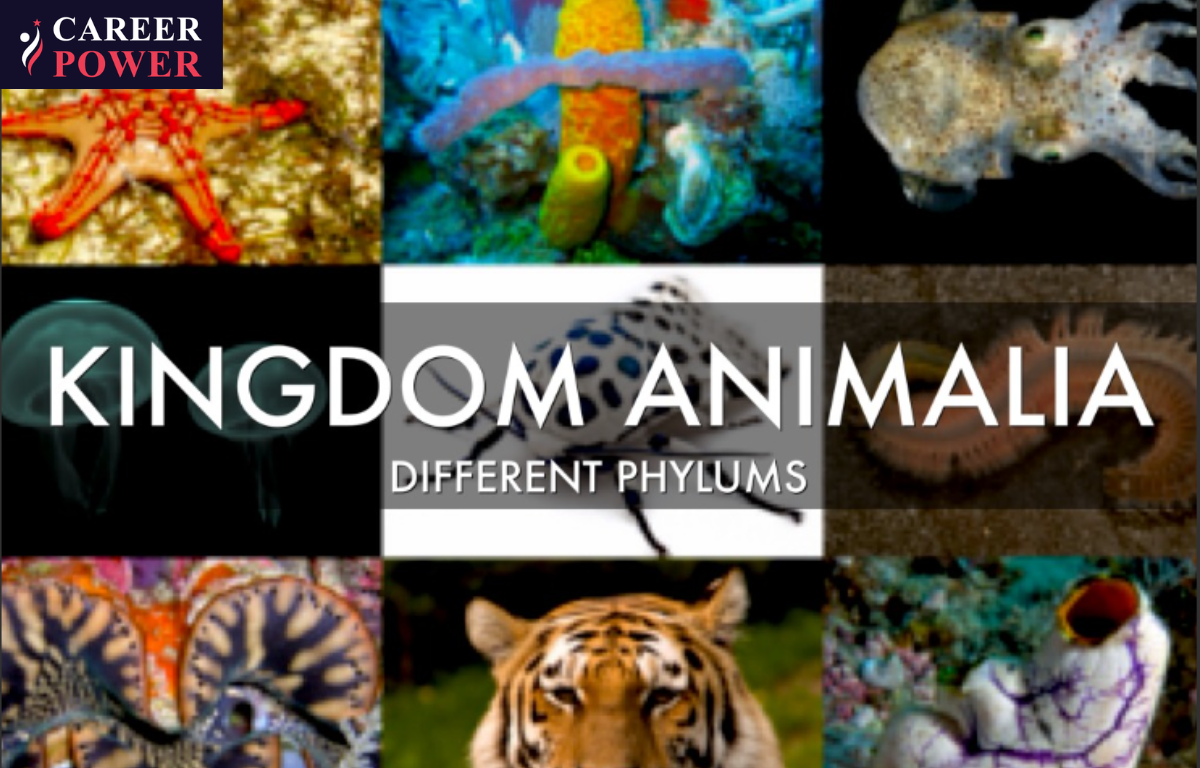

 50 Vegetables Name for Kids in English a...
50 Vegetables Name for Kids in English a...
 Food Chain: Definition, Types, Examples,...
Food Chain: Definition, Types, Examples,...
 Human Respiratory System: Definition, Di...
Human Respiratory System: Definition, Di...













